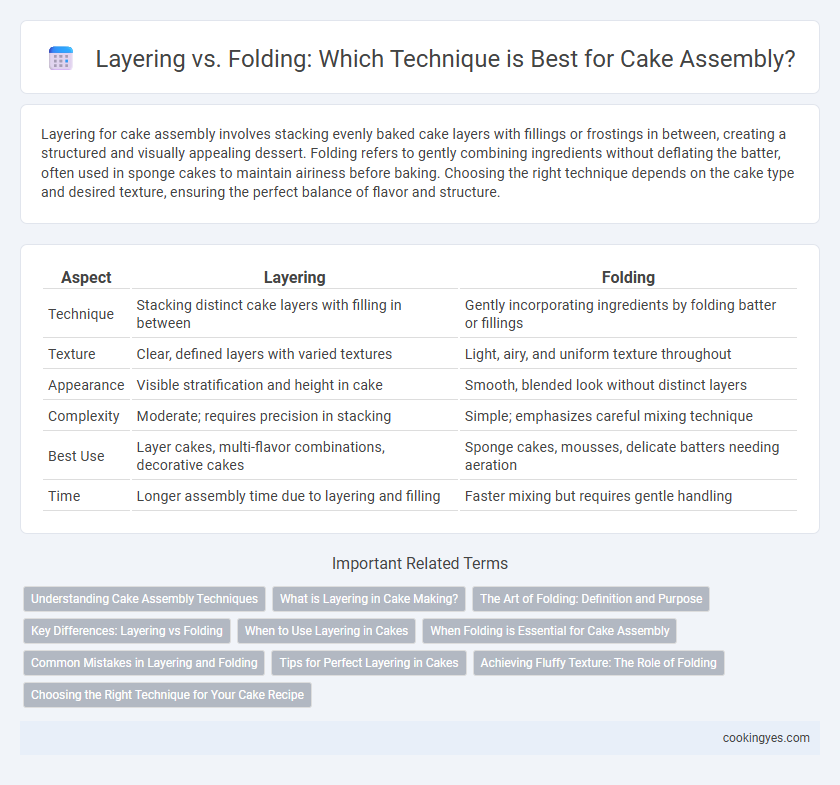Layering for cake assembly involves stacking evenly baked cake layers with fillings or frostings in between, creating a structured and visually appealing dessert. Folding refers to gently combining ingredients without deflating the batter, often used in sponge cakes to maintain airiness before baking. Choosing the right technique depends on the cake type and desired texture, ensuring the perfect balance of flavor and structure.
Table of Comparison
| Aspect | Layering | Folding |
|---|---|---|
| Technique | Stacking distinct cake layers with filling in between | Gently incorporating ingredients by folding batter or fillings |
| Texture | Clear, defined layers with varied textures | Light, airy, and uniform texture throughout |
| Appearance | Visible stratification and height in cake | Smooth, blended look without distinct layers |
| Complexity | Moderate; requires precision in stacking | Simple; emphasizes careful mixing technique |
| Best Use | Layer cakes, multi-flavor combinations, decorative cakes | Sponge cakes, mousses, delicate batters needing aeration |
| Time | Longer assembly time due to layering and filling | Faster mixing but requires gentle handling |
Understanding Cake Assembly Techniques
Layering in cake assembly involves stacking multiple cake layers with frosting or filling evenly spread between each to create a structured, visually appealing dessert. Folding, by contrast, is a gentle mixing technique used primarily during batter preparation to maintain airiness and achieve a light, tender crumb in the final cake. Mastering the distinction between layering and folding is essential for bakers aiming to optimize texture and presentation in their cake creations.
What is Layering in Cake Making?
Layering in cake making involves stacking multiple cake layers with fillings such as buttercream, ganache, or fruit preserves between each tier to create a structured, multi-dimensional dessert. This technique enhances texture and flavor by providing distinct, evenly distributed layers that contribute to the overall stability and aesthetic appeal of the cake. Precise layering ensures even weight distribution, preventing collapse and allowing for clean, professional presentation in cakes like layered birthday cakes or wedding cakes.
The Art of Folding: Definition and Purpose
Folding in cake assembly is a gentle mixing technique used to combine delicate ingredients without deflating air bubbles, essential for maintaining a light and airy texture in sponge or chiffon cakes. This method involves carefully lifting and turning the batter with a spatula to preserve volume, crucial for achieving the desired rise and softness. Proper folding enhances the cake's crumb structure and overall fluffiness, distinguishing it from the denser result often produced by traditional layering methods.
Key Differences: Layering vs Folding
Layering in cake assembly involves stacking distinct cake layers with filling or frosting between each, creating a structured, multi-tiered dessert ideal for showcasing flavor contrasts and textures. Folding refers to a gentle mixing method used primarily in batter preparation, incorporating ingredients without deflating air bubbles, which is crucial for maintaining the cake's light and airy texture. The key difference lies in layering being a post-baking assembly technique enhancing presentation and flavor, while folding is a pre-baking mixing method essential for achieving the desired cake crumb.
When to Use Layering in Cakes
Layering in cake assembly is ideal when creating multi-tiered cakes or desserts that showcase distinct flavors and textures between each tier. Use layering to achieve even distribution of fillings, frostings, and cake layers, providing structural stability and aesthetic appeal for celebration cakes or elaborate designs. This technique is especially effective for buttercream or ganache fillings that require firm support and clean, defined separation.
When Folding is Essential for Cake Assembly
Folding is essential for cake assembly when incorporating delicate ingredients like whipped egg whites or whipped cream to maintain their airy texture and volume. This gentle technique prevents deflation, ensuring a light and fluffy cake structure, which is critical for chiffon or sponge cakes. Layering benefits from folding when combining these prepared components to preserve the cake's softness and prevent it from becoming dense.
Common Mistakes in Layering and Folding
Common mistakes in cake layering include uneven cake layers, which cause instability, and insufficient crumb coating, leading to a messy appearance. Folding errors often arise from over-mixing, which deflates the batter and results in dense, heavy layers instead of light, airy ones. Proper technique requires gentle, consistent folding to maintain the batter's volume and careful alignment during stacking to ensure a structurally sound cake.
Tips for Perfect Layering in Cakes
Achieving flawless cake layers requires evenly leveling each cake tier before stacking to prevent tilting and ensure a smooth finish. Use a serrated knife or cake leveler to trim domed tops, and apply a thin crumb coat of frosting to seal in crumbs and create a stable base for additional layers. Chilling the layers before assembly helps maintain structure and makes handling easier, resulting in a professional-looking layered cake with clean, distinct tiers.
Achieving Fluffy Texture: The Role of Folding
Folding the batter gently incorporates air without deflating the mixture, essential for achieving a light and fluffy cake texture. In contrast, layering refers to assembling the cake after baking and does not affect the batter's aeration. Proper folding techniques preserve the egg whites' volume and create tender crumb structures critical for moist, airy cakes.
Choosing the Right Technique for Your Cake Recipe
Layering ensures even distribution of fillings and stability for multi-tier cakes, ideal for recipes with dense or sturdy textures like sponge or butter cake. Folding blends delicate ingredients gently, preserving airiness in lighter batters such as chiffon or angel food cakes, crucial for maintaining the desired crumb structure. Selecting the appropriate technique depends on the cake's texture and desired presentation, optimizing both taste and appearance.
Layering vs Folding for cake assembly Infographic

 cookingyes.com
cookingyes.com